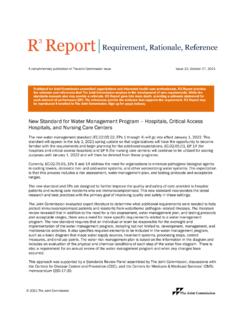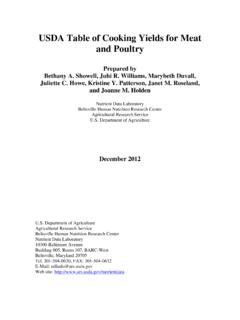Transcription of Unsafe water, sanitation and hygiene - WHO
1 SummaryThe disease burden from Unsafe water , sanitation and hygiene (WSH) isestimated at the global level taking into account various disease out-comes, principally diarrhoeal diseases. The risk factor is defined asincluding multiple factors, namely the ingestion of Unsafe water , lack ofwater linked to inadequate hygiene , poor personal and domestic hygieneand agricultural practices, contact with Unsafe water , and inadequatedevelopment and management of water resources or water estimating disease burden of infectious diarrhoea, exposure sce-narios are established according to water supply and sanitation infra-structure, the level of faecal oral pathogens in the environment andpopulations assigned to these scenarios. The total burdens from schisto-somiasis, trachoma, ascariasis, trichuriasis and hookworm disease are allwholly attributable to Unsafe WSH and have been quantified at globallevel as an additional WSH is an important determinant in a number of additionaldiseases, such as malaria, yellow fever, filariasis, dengue, hepatitis A andhepatitis E, typhoid fever, arsenicosis, fluorosis and legionellosis, someof which present a high disease burden at global infectious diarrhoea, six exposure levels were defined, with thelowest risk level corresponding to an ideal situation where WSH playsno role in disease transmission.
2 Exposure prevalence, in terms of infra-structure, was determined from the Global water Supply and SanitationAssessment 2000. This assessment is a synthesis of major internationalsurveys and national census reports covering 89% of the global popula-tion. The parameters considered included access to improved watersources and improved sanitation risk estimates were based on reviews and large multi-countrystudies for areas with high faecal oral pathogen loads in the environ-ment ( principally in developing countries). The proportion of diseaseChapter 16 Unsafe water , sanitation and hygieneAnnette Pr ss- st n, David Kay, Lorna Fewtrelland Jamie Bartramdue to Unsafe WSH in regions with low faecal oral pathogen loads wasbased on a study analysing the relative importance of etiological agentscausing diarrhoeal diseases, supported by evidence from selected studiesconsidered to be of high quality. A low faecal oral pathogen load in theenvironment was assumed if sanitation coverage exceeded 98% (whichcorresponds to the situation in most developed regions).
3 For the high faecal oral pathogen exposure group, Esrey s multi-country study (1996) suggests that a mean reduction in diarrhoea is possible following the introduction of improved water supplyand sanitation in developing country environments. For the lowfaecal oral pathogen exposure group, data from the study by Mead etal. (1999) suggested that the proportion of diarrhoeal illness attributableto food in the United States of America was approximately 35% (exclud-ing those illnesses wholly transmitted by food). We have therefore esti-mated that approximately 60% was attributable to Unsafe WSH. Areview by Huttly et al. (1997) of epidemiological studies on hygiene prac-tices in seven nations identified a median reduction of diarrhoea inci-dence of 35%.Selected additional studies have suggested ranges of reductions in diar-rhoea incidence that could be achieved by reducing the transmission offaecal oral pathogens through the implementation of interventions, suchas point of use treatment and disinfection of stored water (Quick et ; Semenza et al.)
4 1998). However, this transition has been poorlydocumented by exposure risk information, and we considered it appro-priate to examine both optimistic and pessimistic estimates in definingthe uncertainty around these disease burden from Unsafe WSH was estimated to have been deaths in the year 2000, and 88% of the global burden of diarrhoeal disease due to infectious diarrhoeal diseases. In addition,schistosomiasis, trachoma, ascariasis, trichuriasis and hookworm diseaseare fully attributable to WSH-related factors. Typically, the fraction ofdiarrhoeal disease attributed to Unsafe WSH in developed countries is approximately 60%, whereas in developing countries as much as85 90% of diarrhoeal illness can be attributed to Unsafe WSH. Themajor part is borne by children in developing estimation of the global disease burden caused by Unsafe WSHsuggests a significant burden of preventable disease attributable to thiscause in developing nations, and a non-negligible burden in disease burden caused by the risk factor Unsafe WSH was estimatedat the global level in 1990 (Murray and Lopez 1996a).
5 This original estimate examined WSH in terms of diarrhoeal and selected parasitic diseases, based on the partial attribution of their disease burden to the1322 Comparative Quantification of Health Risksrisk factor. It was found that worldwide the risk factor accounted of all deaths and of all disability-adjusted life years (DALYs).Other communicable ( hepatitis A and E, malaria) and noncommu-nicable diseases (arsenicosis, fluorosis, methaemoglobinaemia) were notconsidered in that for a composite risk factorFaecal oral diseases account for the dominant health outcome of theunsafe WSH risk factor and are the main focus of this chapter. However,not all of them could be included in this estimate ( hepatitis A andE). For infectious diarrhoea, the Unsafe WSH risk factor comprises anumber of transmission routes mediated by a complex interaction ofinfrastructure issues, which might affect, for example, microbiologicalhazards from poor quality drinking water , water availability, microbialrisks from inappropriate disposal of faecal wastes and behaviouralaspects.
6 The transmission routes interact with the efficiency of interven-tions such as hygiene within the home, hand-washing and rigorous appli-cation of point-of-use treatment within domestic properties. Clearly, inany global assessment, the contribution of each element, together withthe plethora of interactions, cannot be precisely quantified in everysetting. However, as hazard estimates come from large surveys performedin several countries (Esrey 1996), variations in behaviour and theireffects on the transmission of faecal oral pathogens have, to some extent,been internalized in our is likely that the relationship between faecal oral pathogen dose andthe probability of infection is log-linear for many of the infectious diar-rhoeal diseases, reaching a plateau for higher exposures (Briscoe 1984;VanDerslice and Briscoe 1995). Sometimes several component causes(see Figure ) may produce similar infection outcomes. This can meanthat the introduction of a single intervention in isolation ( the provi-sion of cleaner water supplies) designed to break an infection pathwaymay result in a negligible reduction in overall disease burden.
7 This is particularly true in communities where the environmental load offaecal oral pathogens is high ( a community with low sanitation coverage, faecally contaminated drinking- water supplies, irregular refusecollection and poor hygiene practices). This renders the attribution of adisease fraction to a specific factor particularly difficult and, indeed,potentially misleading to the policy-making community. For this reason,it is necessary to consider WSH as interrelated parts of a single causalweb in which cutting one major pathway of transmission may well showno (or minimal) effect on the total disease burden, but may, in other cir-cumstances, provoke a dramatic response. Importantly, however, remov-ing a basic pathway ( by providing safe drinking water or improvedsanitation) is likely to be a precondition for the success of subsequentinterventions to reduce disease Pr ss- st n et actions concerning water supply and sanitation ofteninvolve water resource management, including the control of insectvectors of disease (such as malaria) and soil-borne helminths (such asascaris).
8 Similarly, environmental management to control disease vectorsimpacts directly upon water supply and sanitation . Furthermore, accessto improved water sources has a significant impact on exposure to agentsof some water -based diseases (such as schistosomiasis) and diseases withwater-related insect vectors, and improved sanitation reduces certainvector-borne diseases such as trachoma. These intimate interconnectionsof exposure pathways and control mechanisms suggest that treatingwater, including supply and resource management, as an integral part ofthe risk factor Unsafe WSH is of risk factorsUnsafe WSH adversely affects health through multiple Transmission through contact with water that contains organismssuch as Schistosoma Transmission through vectors proliferating in water ecologies relatedto dams, irrigation schemes and other water resources projects ( malaria, schistosomiasis, lymphatic filariasis). This should beincluded although it is currently unclear how or whether it can Quantification of Health RisksHuman excretaWater-borne sewage Hands Soil Animal excreta Surface water Humans Flies Dry sanitation involving reuseFood ground - waterDrinking water Non-recycling latrines PathogensourceMediumEnvironmentInterface Figure pathways of faecal oral disease3.
9 Transmission through the ingestion of water as it occurs duringdrinking and, to some extent, bathing. This category includes dis-eases from faecal oral pathogens, dracunculiasis, arsenicosis, fluo-rosis, from other toxic chemicals and due to excess proliferation oftoxic Transmission caused by poor personal, domestic or agriculturalpractices, including when personal hygiene is affected by lack ofwater. This includes person-to-person transmission of faecal oralpathogens, foodborne transmission of faecal oral pathogens as aresult of poor hygiene or use of contaminated water for irrigationor cleaning. Lack of water is in particular linked to diseases such astrachoma and Transmission through contaminated aerosols from poorly managedwater systems ( legionellosis). water -related injuries that could be prevented by appropriate watermanagement were not considered in the current estimate because of thedifferent management approaches to their remediation.
10 They were,however, covered by the World Health Organization (WHO 1998),although their disease burden was not quantified. Many social, geo-graphic and behavioural factors, such as hygiene , the domestic storageand potential contamination of potable water , the use of sanitation facilities, etc. are important determinants of health outcome. This set offactors has complex social and behavioural drivers that are highly het-erogeneous both within and between nations. In reality, they wouldmodify the effects of the pathways defined in (i) to (v) above. It is beyondthe scope of the current assessment to attempt to quantify the uniqueimpacts of this set of factors in each relating to Unsafe WSH, and their inclusion in the currentestimate, are listed in Table This first assessment of disease burdenshould be considered an initial estimate, which will benefit from refine-ment as additional information becomes available.












